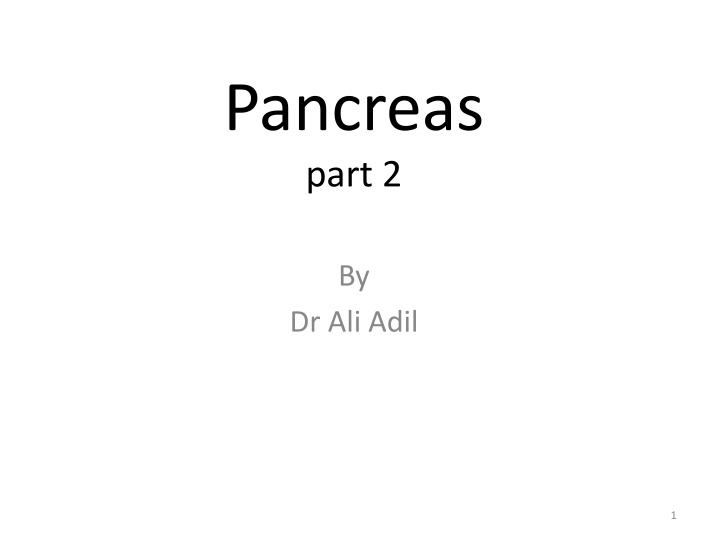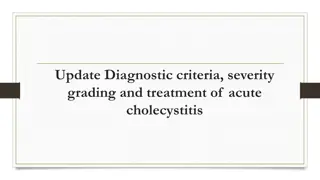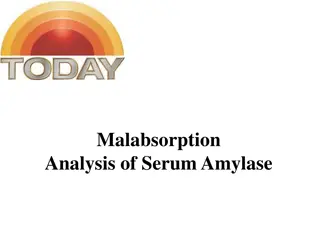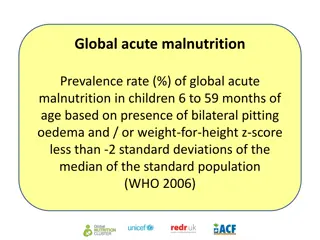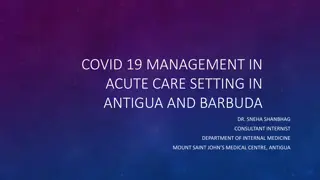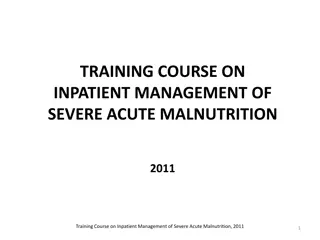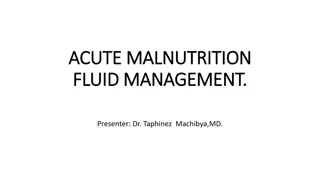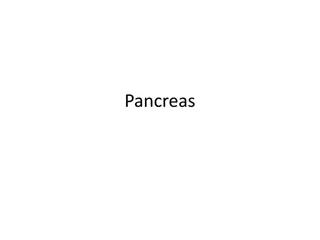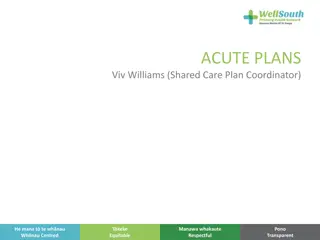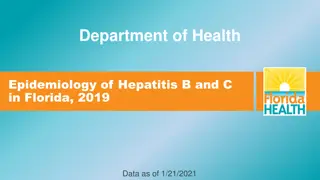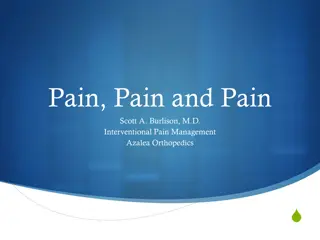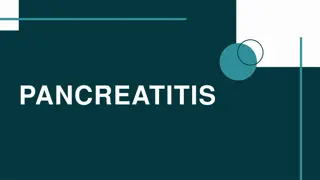Management of Acute Pancreatitis: Mild vs Severe
After assessing the severity of pancreatitis, treatment differs for mild and severe cases. Surgical departments may be involved, with interventions ranging from nil by mouth and IV fluids to aggressive fluid rehydration and supplemental oxygen. Antibiotics and imaging may be necessary in severe cases. Systemic complications require a multidisciplinary approach with supportive therapies like inotropic support and hemofiltration. Local complications may be managed conservatively or with surgical intervention in select cases.
Download Presentation

Please find below an Image/Link to download the presentation.
The content on the website is provided AS IS for your information and personal use only. It may not be sold, licensed, or shared on other websites without obtaining consent from the author.If you encounter any issues during the download, it is possible that the publisher has removed the file from their server.
You are allowed to download the files provided on this website for personal or commercial use, subject to the condition that they are used lawfully. All files are the property of their respective owners.
The content on the website is provided AS IS for your information and personal use only. It may not be sold, licensed, or shared on other websites without obtaining consent from the author.
E N D
Presentation Transcript
Pancreas part 2 By Dr Ali Adil 1
Management After assessing the attack into mild or sever, the treatment is started: In mild pancreatitis: Nursing in surgical department Nil by mouth intravenous fluid administration Analgesics and antiemetic frequent, but non-invasive, observation No need for antibiotic CT scanning is unnecessary unless there is evidence of deterioration 2
In sever pancreatitis: Early management of severe acute pancreatitis. Admission to HDU/ICU Analgesia Aggressive fluid rehydration Supplemental oxygen Invasive monitoring of vital signs, central venous pressure, urine output, blood gases Frequent monitoring of haematological and biochemical parameters (including liver and renal function, clotting, serum calcium, blood glucose 3
Nasogastric drainage (only initially) Antibiotics if cholangitis suspected; prophylactic antibiotics can be considered CT scan essential if organ failure, clinical deterioration or signs of sepsis develop ERCP within 72 hours for severe gallstone pancreatitis or signs of cholangitis Supportive therapy for organ failure if it develops (inotropes, ventilatory support, haemofiltration, etc.) If nutritional support is required, consider enteral (nasogastric) feeding 4
Systemic complications should be managed by a multidisciplinary team appropriate supportive therapies may include: inotropic support for haemodynamic instability haemofiltration in the event of renal failure ventilatory support for respiratory failure correction of coagulopathies. 5
Local complications The management approach is conservative on the whole, with surgery restricted to situations in which conservative management has failed . ACUTE PERIPANCREATIC FLUID COLLECTION Early in the course of mild pancreatitis without necrosis. Has no encapsulating wall. The fluid is sterile Most resolve spontaneously No intervention is necessary unless a large collection causes symptoms or pressure effects. So treatment may include: Percutaneous aspiration under ultrasound or CT guidance. Transgastric drainage under EUS guidance is another option. 7
STERILE AND INFECTED PANCREATIC NECROSIS The term pancreatic necrosis refers to a diffuse or focal area of non-viable parenchyma. Divided into sterile and infected necrosis (sterile often become subsequently infected, probably due to translocation of gut bacteria) Begin as acute necrotic collection (ANC) After 4 weeks it evolve into walled-off necrosis (WON). If sterile with no signs of sepsis, observe. If infected: Needle aspiration under CT guidance, if infected so: Do percutaneous drainage ( by a placement of tube drain with frequent flushing) If sepsis continue; then a pancreatic necrosectomy should be considered 8
Necrosectomy should be necessary in a very small proportion of patients. Midline approach if necrosis involving the head of pancreas. Retroperitoneal approach if necrosis involving the body or tail. Can be done by rigid laparoscope Once a necrosectomy has been completed, further necrotic tissue may form, so drain by one of: Closed continuous lavage: Tube drains are left in and the raw area flushed. Closed drainage: The incision is closed, but the cavity is packed with gauze-filled Penrose drains and closed suction drains. Open packing: The incision is left open. Closure and relaparotomy: The incision is closed with drains with the intention of performing a series of planned relaparotomies every 48 72 hours until the raw area granulates. 10
PANCREATIC ABSCESS This is a circumscribed intra-abdominal collection of pus, usually in proximity to the pancreas. It may be an ANC or a WON that has become infected. Diagnosis and treatment is just like that of infected pancreatic necrosis. 11
PANCREATIC ASCITES This is a chronic, generalised, peritoneal, enzyme-rich effusion usually associated with pancreatic duct disruption Paracentesis will reveal turbid fluid with a high amylase level. Treatment: Adequate drainage with wide-bore drains placed under imaging guidance Suppressing pancreatic secretion by: parenteral or nasojejunal feeding Administration of octreotide. ERCP may allow demonstration of the duct disruption and placement of a pancreatic stent. PANCREATIC EFFUSION There may be a communication with an intra-abdominal collection Require drainage 12
HAEMORRHAGE Bleeding may occur into the gut, into the retroperitoneum or into the peritoneal cavity. Possible causes include bleeding into: a pseudocyst cavity, diffuse bleeding from a large raw surface, a pseudoaneurysm. Recurrent , could be fatal Diagnosis by CT, angiography or MR angiography Treatment involves embolisation or surgery PORTAL OR SPLENIC VEIN THROMBOSIS A marked rise in the platelet count should raise suspicions. 13
PSEUDOCYST A pseudocyst is a collection of amylase-rich fluid enclosed in a well-defined wall of fibrous or granulation tissue typically arise following an attack of mild acute pancreatitis Represent an APFC that has not resolved and matured. It requires 4 weeks or more to develop. 50% have a communication with the main pancreatic duct, usually single. Diagnosis by ultrasound or a CT scan. ERCP and MRCP may demonstrate communication of the cyst with the pancreatic duct system 14
Differential diagnosis: APFC cystic neoplasm Pseudocysts will resolve spontaneously in most instances, but complications can develop: 15
Factors making a Pseudocyst less likely to resolve spontaneously: thick-walled Pseudocysts large (over 6 cm in diameter lasted for a long time (over 12 weeks) had arisen in the context of chronic pancreatitis Indications of surgery: If the pseudocyst causes symptoms If complications develop If a distinction has to be made between a pseudocyst and a tumour 16
Treatment: percutaneous Percutaneous drainage percutaneous transgastric cystgastrostomy endoscopic: transgastric endoscopic drainage ERCP and placement of a pancreatic stent Surgical drainage involves internally draining the cyst into the gastric or jejunal lumen Recurrence rates should be no more than 5% 17
Outcomes and follow-up of acute pancreatitis: The overall mortality from acute pancreatitis has remained at10 15% We should determine the aetiology of the attack of pancreatitis. Patients in the idiopathic group who suffer repeated attacks may prove to have biliary microlithiasis. In a patient who has gallstone pancreatitis, the gallbladder and gallstones should be removed as soon as the patient is fit to undergo surgery. 18
Chronic pancreatitis Chronic pancreatitis is a progressive inflammatory disease in which there is irreversible destruction of pancreatic tissue. Clinically : sever pain (attacks of acute pancreatitis) later on, exocrine and endocrine insufficiency The disease occurs more frequently in men (male: female ratio of 4:1), and the mean age of onset is about 40 years. 19
Aetiology and pathology High alcohol consumption is the most frequent cause of chronic pancreatitis, accounting for 60 70% of cases. Only 5 10% of people with alcoholism develop chronic pancreatitis. Hyperlipidemia and hypercalcaemia can lead to chronic pancreatitis. Other causes include Pancreatic duct obstruction resulting from stricture formation: After trauma. After acute pancreatitis Occlusion of the duct by pancreatic cancer Pancreas divisum and annular pancreas are rare causes of chronic pancreatitis. 20
Hereditary pancreatitis, CF, infantile malnutrition and a large unexplained idiopathic group make up the remainder. In Hereditary pancreatitis there is mutation in SPINK1 (responsible for destruction of activated trypsinogen), also this mutation predisposes to idiopathic pancreatitis. Idiopathic chronic pancreatitis accounts for approximately 30% of cases. Hereditary pancreatitis and pancreatitis occurring at a young age had a markedly increased risk of developing pancreatic cancer especially in smoker patients 21
Tropical pancreatitis is a form of idiopathic pancreatitis that begins at a young age and is associated with a high incidence of diabetes mellitus and stone formation , caused by either: Malnutrition ingestion of cyanogenic glycosides in cassava exposure to hydrocarbons released by kerosene or paraffin lamps Autoimmune pancreatitis is a recently described cause of chronic pancreatitis, May occur alone or as part of autoimmune process. May cause changes in the biliary tree (autoimmune cholangiopathy) Autoantibodies may be present, and levels of the immunoglobulin subtype IgG4 are elevated. 22
Pathology: The pancreas enlarges and becomes hard as a result of fibrosis. The ducts become distorted and dilated with areas of both stricture formation and ectasia Calcified stones Become occluded with a gelatinous proteinaceous fluid and debris. Inflammatory cysts may form. 23
Clinical features Pain is the outstanding symptom in the majority of patients, the site of pain depend on the part of pancreas affected: Epigastric and right subcostal pain if the head of pancreas is diseased. Left subcostal and back pain if the disease limited to the left side of the pancreas. In some patients, the pain is more diffuse. Radiation to the shoulder can occur. The pain is often dull and gnawing. Severe flare-ups of pain may be superimposed on background discomfort. The pain prevents sleep and time off work is frequent. 24
Nausea is common during attacks, and vomiting may occur. Weight loss Loss of exocrine function leads to steatorrhoea in more than 30% of patients. Loss of endocrine function leads to the development of diabetes, incidence increases as the disease progresses. Infection is not infrequent, possibly related to the diabetes mellitus. 25
Investigations a rise in serum amylase (Only in the early stages of the disease) Pancreatic calcifications may be seen on abdominal X-ray and CT scan. CT or MRI scan will show the outline of the gland, the main area of damage and the possibilities for surgical correction (a normal looking pancreas on CT or MRI does not rule out chronic pancreatitis). MRCP will identify the presence of biliary obstruction and the state of the pancreatic duct. ERCP is the most accurate way of elucidating the anatomy of the duct and, in conjunction with the whole organ morphology, can help to determine the type of operation required, if operative intervention is indicated. Histology in case of unproven chronic pancreatitis. EUS 26
Treatment Most patients can be managed with medical measures. There is no single therapeutic agent that has been shown to relieve symptoms. The role of surgery is to overcome obstruction and remove mass lesions. Patients have a mass in the head of the pancreas, for which either a pancreatoduodenectomy or a Beger procedure (duodenum-preserving resection of the pancreatic head) is appropriate. If the duct is markedly dilated, then a longitudinal pancreatojejunostomy or Frey procedure can be of value. 29
The rare patient with disease limited to the tail will be cured by a distal pancreatectomy. Patients with intractable pain and diffuse disease may plead for a total pancreatectomy. Total pancreatectomy and islet autotransplantation has been reported in selected patients. 30
Prognosis Patients often suffer a gradual decline in their professional, social and personal lives. After a surgical or percutaneous intervention, the pain disappears but tends to return over a period of time. After many years, there may be disappearance of the pain, leaving only the exocrine and endocrine insufficiencies. Development of pancreatic cancer is a risk in those who have had the disease for more than 20 years. 32
Sphincter of Oddi dysfunction The sphincter of Oddi is 6 10 mm long and lies within the duodenal wall. A part of it encircles the common channel, and then there are separate biliary and pancreatic components. 33
Sphincter of Oddi dyskinesia or dysfunction (SOD) is a clinical syndrome in which pain, biochemical abnormalities and dilatation of the bile duct and/or pancreatic duct are attributed to abnormal function of the sphincter of Oddi. Females are more commonly affected than males. Biliary-type SOD Is characterised by biliary pain, which may be accompanied by abnormally raised liver enzymes and/or dilation of the bile duct and/or evidence of delayed emptying on biliary scintigraphy. It may be a cause of persistent post-cholecystectomy symptoms. 34
pancreatic-type SOD Predominance of pancreatic problems, especially recurrent episodes of acute pancreatitis. Should be excluded in patients with recurrent acute pancreatitis of unexplained aetiology. CT and MRCP can demonstrate dilatation of the biliary and pancreatic ducts. MRCP with intravenous secretin injection can particularly demonstrate pancreatic duct dilatation due to raised sphincter pressures. HIDA scan may demonstrate delayed biliary transit. The gold standard for diagnosing SOD is ERCP with manometry of the biliary and pancreatic sphincters, (Sphincter pressure higher than 40 mm Hg is the manometric criterion used to diagnose SOD). 35
Treatment: Endoscopic sphincterotomy Medical therapy should be tried before proceeding to manometry. Proton pump inhibitors, spasmolytic drugs, calcium blockers (nifedipine), and psychotropic agents have all been tried with varying degrees of success. Injection of botulinum toxin (which can cause a chemical sphincterotomy for up to 3 months) or placement of a pancreatic stent (these are usually removed after 6 weeks) do not provide lasting relief, but can be used to identify patients who may benefit from a sphincterotomy. 36
CARCINOMA OF THE PANCREAS Pancreatic cancer is the sixth leading cause of cancer death in the UK. The incidence is 10 cases per 100 000 population per year. 37
Pathology More than 85% of pancreatic cancers are ductal adenocarcinomas. Endocrine tumours of the pancreas are rare. Ductal adenocarcinomas arise most commonly in the head of the gland. They are solid, scirrhous tumours, characterised by neoplastic tubular glands within a markedly desmoplastic fibrous stroma. Fibrosis is also a characteristic of chronic pancreatitis, and histological differentiation between tumour and pancreatitis can cause diagnostic difficulties 39
Proliferative lesions in the pancreatic ducts can precede invasive ductal adenocarcinoma. These are termed pancreatic intraepithelial neoplasia or PanIN. Cystic tumours of the pancreas may be serous or mucinous. Serous cystadenomas found in older women Are large aggregations of multiple small cysts, almost like bubblewrap. Benign. 40
Mucinous tumours Have the potential for malignant transformation. They include mucinous cystic neoplasms (MCNs) and intraductal papillary mucinous neoplasms (IPMNs). MCNs: Perimenopausal women. Show up as multilocular thick-walled cysts in the pancreatic body or tail. Histologically, contain an ovarian-type stroma. 41
IPMNs: More common in the pancreatic head and in older men. IPMNs arising within the main duct are often multifocal and have a greater tendency to prove malignant. IPMN arising from a branch duct can be difficult to distinguish from an MCN. Thick mucus seen extruding from the ampulla at ERCP is diagnostic of a main duct IPMN. Solid pseudopapillary tumour is a rare, slowly progressive but malignant tumour, seen in women of childbearing age, and manifests as a large, part-solid, part-cystic tumour 42
Peri-ampullary tumors oTumours arising from the ampulla or from the distal common bile duct. oPresent as a mass in the head of the pancreas. oConstitute around a third of all tumours in that area. oPatients with familial adenomatous polyposis (FAP) can present with multiple duodenal polyps. oMalignant transformation in a duodenal polyp is a significant cause of mortality in these patients. Ampullary carcinomas are relatively small when diagnosed, which may account for their better prognosis than pancreatic ductal adenocarcinoma 43
Clinical features Jaundice secondary to obstruction of the distal bile duct is the most common symptom. It is characteristically painless Pruritus, dark urine and pale stools with steatorrhoea are common accompaniments of jaundice. Associated with nausea and epigastric discomfort. In the absence of jaundice, symptoms are often non-specific, namely vague discomfort, anorexia and weight loss. 44
Patients should suspected and followed are: Upper abdominal symptoms in a recently diagnosed diabetic, especially in one above50 years. a patient with an unexplained attack of pancreatitis. Tumours of the body and tail of the gland often grow silently, and present at an advanced unresectable stage. Back pain is a worrying symptom, raising the possibility of retroperitoneal infiltration. 45
On examination: Jaundice weight loss a palpable liver A palpable gall bladder, Courvoisier,s law : when the common duct is obstructed by a stone, distension of the gall bladder (which is likely to be chronically inflamed) is rare; when the duct is obstructed in some other way, such as a neoplasm, distension of the normal gall bladder is common. 46
Investigation CBP and LFTs U/S : it may shows CBD dilatation, if so: The preferred test is the contrast- enhanced CT scan, it can show tumour in the pancreas and if it is resectable. contraindications to surgical resection: 1. hepatic or peritoneal metastases 2. lymph node metastases distant from the pancreatic head 3. encasement of the superior mesenteric, hepatic or coeliac artery by tumour 47
ERCP and biliary stenting should be carried out if there is any suggestion of cholangitis, If there is diagnostic doubt. Jaundiced with distressing pruritus. Besides imaging, ERCP also provide a brush cytology or biopsy specimen to confirm the diagnosis. The prothrombin time should be checked, and clotting abnormalities should be corrected with vitamin K or fresh-frozen plasma prior to ERCP 48
EUS is indicated in: If CT fails to demonstrate a tumour. If tissue diagnosis is required prior to surgery. If vascular invasion needs to be confirmed. in separating cystic tumours from pseudocysts Histological confirmation of malignancy is desirable but not essential, particularly if the imaging clearly demonstrates a resectable tumour. Tissue diagnosis should be obtained prior to starting palliative therapy. Diagnostic laparoscopy is useful in identifying small peritoneal and liver metastases. CA19-9 is not highly specific or sensitive, but a baseline level should be established; if it is initially raised, it can be useful 49
Management At the time of presentation, more than 85% of patients with ductal adenocarcinoma are unsuitable for resection because the disease is too advanced. If imaging shows that the tumour is potentially resectable, the patient should be considered for surgical resection. For those patients who have inoperable disease, palliative treatment should be offered. 50
